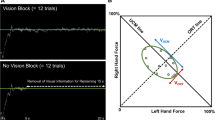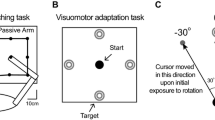Abstract
The direction of the asymmetry of inter-limb transfer has been suggested to identify the specialization of each hemisphere when performing a motor task. In an earlier study, we showed that trajectory information is only transferred from the right to the left hand, while final movement outcome-associated parameters transferred in both directions when right-hand-dominant individuals perform a motor task with visual distorted feedback. In the current study, we try to replicate this finding in young adults and test whether the asymmetry of inter-limb transfer in visuomotor task reduces in older adults, suggesting that hemispheric lateralization reduces with age. Young and older adults (all right-hand-dominant) performed a multidirectional point-to-point drawing task in which the visual feedback was rotated and the gain was increased. Half of the participants in each age group trained with the right hand and the other half trained with the left hand. Performances of both hands with non-distorted and distorted visual feedback were collected from all participants before and after the training session. The results showed that the pattern of inter-limb transfer was similar between young and older adults, i.e., inter-limb transfer is asymmetric for initial direction and symmetric for movement time and trajectory length. The results suggest that older adults retain the specialized functions of the non-dominant (right) hemisphere allowing them to program movement direction of a graphic aiming task when visual feedback is distorted.




Similar content being viewed by others
References
Anguera JA, Russell CA, Noll DC, Seidler RD (2007) Neural correlates associated with intermanual transfer of sensorimotor adaptation. Brain Res 1185:136–151
Balitsky Thompson AK, Henriques DYP (2010) Visuomotor adaptation and intermanual transfer under different viewing conditions. Exp Brain Res 202(3):543–552
Cabeza R (2002) Hemispheric asymmetry reduction in older adults: the HAROLD model. Psychol Aging 17(1):85–100
Cabeza R, Anderson ND, Locantore JK, McIntosh AR (2002) Aging gracefully: compensatory brain activity in high-performing older adults. NeuroImage 17(3):1394–1402
Cabeza R, Daselaar SM, Dolcos F, Prince SE, Budde M, Nyberg L (2004) Task-independent and task-specific age effects on brain activity during working memory, visual attention and episodic retrieval. Cereb Cortex 14(4):364–375
Criscimagna-Hemminger SE, Donchin O, Gazzaniga MS, Shadmehr R (2003) Learned dynamics of reaching movements generalize from dominant to nondominant arm. J Neurophysiol 89(1):168–176
Di Fabio RP, Emasithi A (1997) Aging and the mechanisms underlying head and postural control during voluntary motion. Phys Ther 77(5):458–475
Folstein MF, Folstein SE, McHugh PR (1975) “Mini-mental state”. A practical method for grading the cognitive state of patients for the clinician. J Psychiat Res 12(3):189–198
Gazzaniga MS (1970) The Bisected brain. Neuroscience series, 2. Appleton-Century-Crofts, New York
Ghilardi M, Ghze C, Dhawan V, Moeller J, Mentis M, Nakamura T, Antonini A, Eidelberg D (2000) Patterns of regional brain activation associated with different forms of motor learning. Brain Res 871:127–145
Hellige JB (1993) Hemispheric asymmetry: what’s right and what’s left. Perspectives in cognitive neuroscience. Harvard University Press, Cambridge, Mass
Hicks RE (1974) Asymmetry of bilateral transfer. Am J Psychol 87(4):667–674
Hinder MR, Schmidt MW, Garry MI, Carroll TJ, Summers JJ (2011) Absence of cross-limb transfer of performance gains following ballistic motor practice in older adults. J Appl Physiol 110:166–175
Hinder MR, Carroll TJ, Summers JJ (2013) Inter-limb transfer of ballistic motor skill following non-dominant limb training in young and older adults3. Exp Brain Res 227:19–29
Imamizu H, Shimojo S (1995) The locus of visual-motor learning at the task of manipulator level—implications from intermanual transfer. J Exp Psychol Human 21(4):719–733
Inoue K, Kawashima R, Satoh K, Kinomura S, Goto R, Sugiura M, Ito M, Fukuda H (1997) Activity in the parietal area during visuomotor learning with optical rotation. Neuroreport 8(18):3979–3983
Inoue K, Kawashima R, Satoh K, Kinomura S, Sugiura M, Goto R, Ito M, Fuckuda H (2000) A PET study of visuomotor learning under optical rotation. Neuroimage 11:505–516
Krakauer JW, Ghilardi MF, Mentis M, Barnes A, Veytsman M, Eidelberg D, Ghez C (2004) Differential cortical and subcortical activations in learning rotations and gains for reaching: a PET study. J Neurophysiol 91(2):924–933
Kumar S, Mandal MK (2005) Bilateral transfer of skill in left- and right-handers. Laterality 10(4):337–344
Langan J, Seidler RD (2011) Age differences in spatial working memory contributions to visuomotor adaptation and transfer. Behav Brain Res 225(1):160–168
Langan J, Peltier SJ, Bo J, Fling BW, Welsh RC, Seidler RD (2010) Functional implications of age differences in motor system connectivity. Frontiers Syst Neurosci 4:17
Mutha PK, Sainburg RL, Haaland KY (2011) Left parietal regions are critical for adaptive visuomotor control. J Neurosci 31(19):6972–6981
Mutha PK, Haaland KY, Sainburg RL (2012) The effects of brain lateralization on motor control and adaptation. J Mot Behav 44(6):455–469
National Institute on Aging and the World Health Organization (2011) Global health and aging. U.S. Department of Health and Human Services, Washington. Retrieved from http://www.nia.nih.gov/sites/default/files/global_health_and_aging.pdf
Oldfield RC (1971) The assessment and analysis of handedness: the Edinburgh inventory. Neuropsychologia 9(1):97–113
Pai YC, Wening JD, Runtz EF, Iqbal K, Pavol MJ (2003) Role of feedforward control of movement stability in reducing slip-related balance loss and falls among older adults. J Neurophysiol 90(2):755–762
Pan Z, Van Gemmert AWA (2013) The direction of bilateral transfer depends on the performance parameter. Hum Move Sci, http:dx.doi.org/10.1016/j.humov.2012.02.013
Parlow SE, Kinsbourne M (1989) Asymmetrical transfer of training between hands—implications for interhemispheric communication in normal brain. Brain Cogn 11(1):98–113
Przybyla A, Haaland KY, Bagesteiro LB, Sainburg RL (2011) Motor asymmetry reduction in older adults. Neuros Lett 489(2):99–104
Sainburg RL (2002) Evidence for a dynamic-dominance hypothesis of handedness. Exp Brain Res 142(2):241–258
Sainburg RL, Wang J (2002) Interlimb transfer of visuomotor rotations: independence of direction and final position information. Exp Brain Res 145(4):437–447
Schaefer S, Schumacher V (2011) The interplay between cognitive and motor functioning in healthy older adults: findings from dual-task studies and suggestions for intervention. Gerontology 57(3):239–246
Seidler RD (2007) Aging affects motor learning but not savings at transfer of learning. Learn Mem 14(1–2):17–21
Taylor HG, Heilman KM (1980) Left-hemisphere motor dominance in righthanders. Cortex 16(4):587–603
Teixeira LA (2000) Timing and force components in bilateral transfer of learning. Brain Cogn 44(3):455–469
Thut G, Cook ND, Regard M, Leenders KL, Halsband U, Landis T (1996) Intermanual transfer of proximal and distal motor engrams in humans. Exp Brain Res 108(2):321–327
Walker N, Philbin DA, Fisk AD (1997) Age-related differences in movement control: adjusting submovement structure to optimize performance. J Gerontol Psychol Sci 52(1):P40–P52
Wang J, Sainburg RL (2004) Interlimb transfer of novel inertial dynamics is symmetrical. J Neurophysiol 92:349–360
Wang J, Sainburg RL (2006) The symmetry of interlimb transfer depends on workspace locations. Exp Brain Res 170(4):464–471
Wang J, Przybyla A, Wuebbenhorst K, Haaland KY, Sainburg RL (2011) Aging reduces asymmetries in interlimb transfer of visuomotor adaptation. Exp Brain Res 210(2):283–290
Acknowledgments
This research was partially funded by an LSU Life Course and Aging Center (LCAC) graduate assistant enhancement and a Lillia Oleson Scholarship award. The preliminary results were presented at the Conference of Progress in Motor Control VIII (PMCVIII), Cincinnati, OH, 2011.
Author information
Authors and Affiliations
Corresponding author
Rights and permissions
About this article
Cite this article
Pan, Z., Van Gemmert, A.W.A. The effects of aging on the asymmetry of inter-limb transfer in a visuomotor task. Exp Brain Res 229, 621–633 (2013). https://doi.org/10.1007/s00221-013-3625-y
Received:
Accepted:
Published:
Issue Date:
DOI: https://doi.org/10.1007/s00221-013-3625-y




